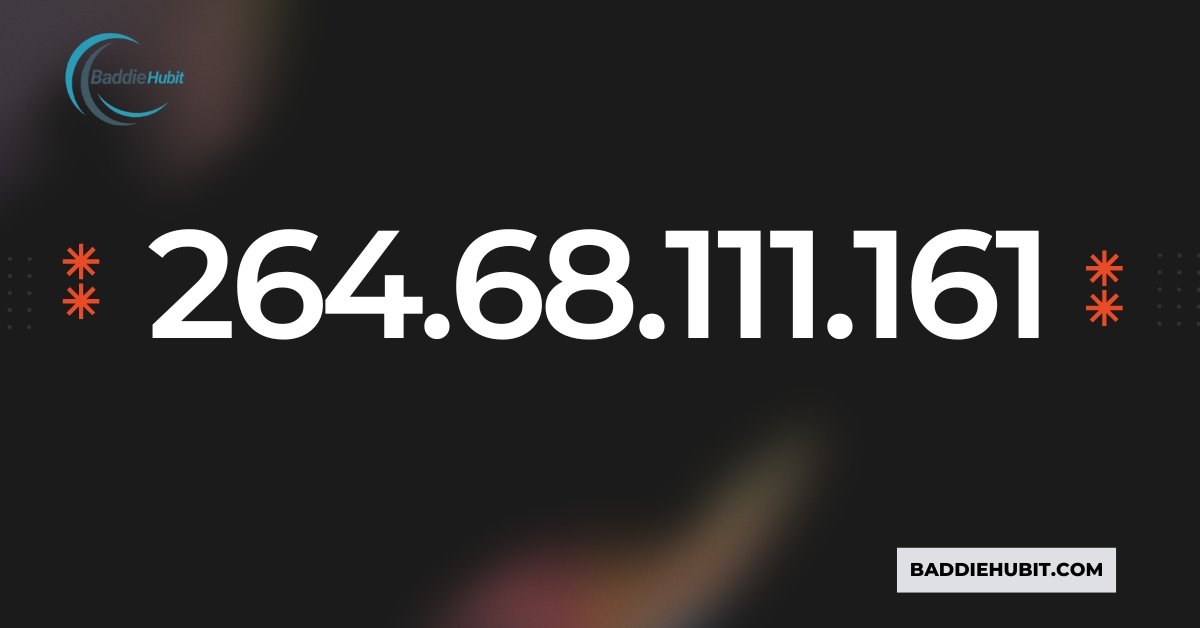The world of digital networking revolves around precise systems, one of which is the IP address. Every device connected to the internet is assigned a unique identifier known as an IP address that helps in identification and communication. However, not every IP address that “looks” real is actually valid. A great example of this is 264.68.111.161, an address that seems legitimate but is actually invalid.
In this comprehensive article, we’ll explore what makes 264.68.111.161 invalid, the structure of IP addresses, their uses, risks associated with invalid addresses, and more.
✅ What Is an IP Address and Why Does It Matter?
An IP address (Internet Protocol address) is like a digital mailing address. It identifies a device on a network and enables communication between different machines over the internet or local networks. Without IP addresses, devices wouldn’t know where to send or receive data.
There are two major versions of IP addresses:
-
IPv4 (e.g., 192.168.1.1)
-
IPv6 (e.g., 2001:0db8:85a3:0000:0000:8a2e:0370:7334)
Each serves the same function but differs in structure and capacity.
🧱 IPv4 Structure and Why 264.68.111.161 Is Invalid
IPv4 addresses are made up of four octets, each separated by a dot, such as:
Each octet must be a number between 0 and 255. Therefore, any number above 255 is considered out of range, which makes the address invalid.
Let’s break down 264.68.111.161:
-
264 ❌ (Invalid – more than 255)
-
68 ✅
-
111 ✅
-
161 ✅
Because the first number is 264, the entire address becomes invalid under IPv4 standards.
🔎 What Happens If You Try to Use 264.68.111.161?
If you attempt to:
-
Ping this address using networking tools
-
Assign it to a server or device
-
Access it through a browser
you’ll receive an error. Since the IP is not within the allowable range, routers and networking systems won’t recognize it.
Most lookup tools or geo-IP services will show an error or return “IP address not found”.
📚 Why Do Invalid IPs Like 264.68.111.161 Appear?
There are several common scenarios where such addresses may be seen:
-
Typographical Errors: The user may have mistakenly typed 264 instead of 164.
-
Example Data: Authors and instructors often use fake IPs to teach concepts without referencing a real system.
-
Obfuscation: Sometimes people intentionally use fake IPs to hide actual data in logs or documentation.
-
Malicious Intent: Cyber attackers may use invalid IPs to confuse or bypass tracking systems.
🌐 Who Controls IP Address Assignment?
Globally, IP address allocation is regulated by:
-
IANA (Internet Assigned Numbers Authority)
-
RIRs (Regional Internet Registries) like:
-
ARIN (North America)
-
RIPE NCC (Europe)
-
APNIC (Asia-Pacific)
-
These bodies ensure that IP addresses are:
-
Unique
-
Properly distributed
-
Trackable for security and administrative purposes
⚠️ Security Concerns Related to Invalid IPs
While an address like 264.68.111.161 won’t work in practice, its presence in logs or systems can be suspicious. Here’s why:
-
Fake IPs in server logs could indicate hacking attempts.
-
Improperly configured firewalls might misinterpret or mishandle invalid IPs.
-
Spam bots often generate fake IPs to avoid detection or bans.
Thus, system administrators and cybersecurity teams must scrutinize all unusual IP entries, even if they seem harmless.
🔧 How to Detect and Avoid Invalid IP Addresses
Here’s how to prevent or identify invalid IP usage:
-
✅ Use IP validation tools in your code or system.
-
✅ Double-check IPs when entered manually in settings.
-
✅ Filter out invalid addresses in your logs and reports.
-
✅ Set up firewall rules to reject malformed IP entries.
Online tools like IP lookup services or built-in system utilities (ping, tracert, netstat) can help determine if an IP is valid and reachable.
📊 IPv4 vs. IPv6 Comparison
| Feature | IPv4 | IPv6 |
|---|---|---|
| Address Size | 32-bit | 128-bit |
| Example Format | 192.0.2.1 | 2001:db8::ff00:42:8329 |
| Address Limit | ~4.3 billion | ~340 undecillion |
| Launch Date | 1980s | 1998 (widely adopted in 2010s onward) |
| Security | Basic (can be enhanced) | More secure with built-in IPsec |
| Efficiency | Suitable but limited | Designed for scalability and growth |
IPv6 was introduced to handle the shortage of IPv4 addresses and includes advanced features such as autoconfiguration, encryption, and greater efficiency.
🔁 Real-Life Uses of Invalid IPs
Even though 264.68.111.161 is not functionally usable, it still appears in some contexts:
-
📘 Textbooks & Tutorials – For educational examples.
-
🖥️ Placeholder Content – In template codes or websites.
-
🕵️ Cyber Forensics – To study how fake data is used to mislead.
These fake addresses serve a purpose—but only when the context makes their fake nature clear.
🧠 Quick Facts Recap: 264.68.111.161
-
❌ Not a valid IPv4 address.
-
❌ Not assigned by any regional IP authority.
-
🚫 Won’t resolve in IP lookup tools.
-
⚠️ May signal error, typo, or malicious intent if found in logs.
✅ Conclusion: Why Knowing Invalid IPs Matters
Understanding why 264.68.111.161 is invalid isn’t just a tech formality—it’s part of good networking hygiene. In a world where IP addresses are crucial to everything from browsing the web to running enterprise systems, distinguishing between valid and invalid addresses is vital.
By learning the format rules and security concerns surrounding IP addresses, both users and professionals can better protect their systems, troubleshoot issues, and avoid common mistakes.




